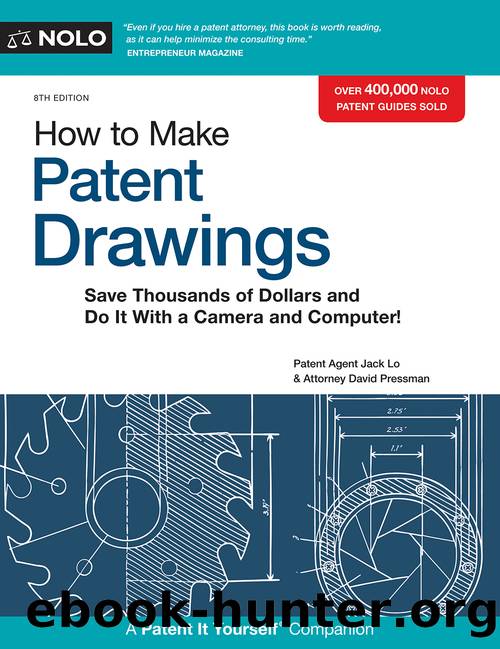How to Make Patent Drawings by Jack Lo & David Pressman

Author:Jack Lo & David Pressman [Jack Lo and David Pressman]
Language: eng
Format: epub
Publisher: NOLO
Published: 2019-01-15T00:00:00+00:00
Illustration 6.18âVary Hatching to Distinguish Adjacent Regions
Illustration 6.19âHatch Angle on Different Areas of Same Part
Illustration 6.20âThin Versus Thick Hatch Lines
Illustration 6.21âEnlarged View
Inventions With Moving Parts
An invention with moving parts should be shown with the parts positioned in an initial or at-rest condition. Movement of the parts may be shown in several different ways.
Arrow. If the movement of a part is simple, it may simply be indicated by an arrow, such as the rotation of the hinged arm in Illustration 6.22.
Moved part. If it is necessary for comprehension, a part may be drawn in solid lines to show it in its initial position and drawn in phantom lines (dot-dot-dash lines) in the same figure to show it in a moved position. This should be done only if there is no risk of confusion. Illustration 6.23 shows both the original and moved positions of a sleeve on a rod.
Separate figures. The initial position of a part may be shown in solid lines in one figure, and its moved position in solid lines in a separate figure, such as the sleeve and rod in Illustration 6.24. The movement of the part may be indicated by an optional arrow. The separate figures should not be connected.
Long sequence. A complicated invention should be illustrated with a sequence of figures to clearly show the movements and interactions of all the parts in as many distinct steps as necessary. Illustrations 6.25 through 6.32 show the different figures for illustrating a fairly complicated inventionâa dual-cycle toilet flusher that provides selectable small- and big-capacity flushes.
Download
This site does not store any files on its server. We only index and link to content provided by other sites. Please contact the content providers to delete copyright contents if any and email us, we'll remove relevant links or contents immediately.
Social Media Law in a Nutshell by Ryan Garcia & Thaddeus A Hoffmeister(1511)
You Don't Own Me by Orly Lobel(1424)
Intellectual Property Strategy by John Palfrey(1401)
Hello, My Name is Awesome by Alexandra Watkins(1337)
Without Copyrights by Spoo Robert(1334)
Profit From Your Idea: How to Make Smart Licensing Deals by Attorney Richard Stim(1314)
The Trademark Guide by Lee Wilson(1217)
Democracy of Sound by Alex Sayf Cummings(1200)
A Triumph of Genius: Edwin Land, Polaroid, and the Kodak Patent War by Ronald K. Fierstein(1186)
The Copywriter's Handbook by Robert W. Bly(1168)
Kafka's Last Trial by Benjamin Balint(1149)
World War 3.0 by Ken Auletta(1144)
Data Protection: A Practical Guide to UK and EU Law by Carey Peter(1127)
What They'll Never Tell You About the Music Business by Peter M. Thall(1079)
Mass Media Law by Pember Don & Pember Don(1062)
BVR's Guide to Intellectual Property Valuation by Michael Pellegrino(1060)
The Tech Contracts Handbook: Software Licenses and Technology Services Agreements for Lawyers and Businesspeople by David Tollen(1055)
Patent It Yourself: Your Step-by-Step Guide to Filing at the U.S. Patent Office by Pressman David Attorney(1050)
Hello, My Name Is Awesome: How to Create Brand Names That Stick (BK Business) by Alexandra Watkins(1047)
